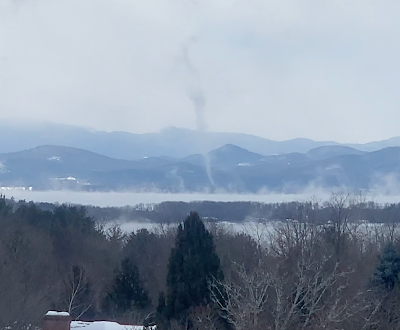Oh, we have a sudden stratospheric warming! The polar vortex is going to go haywire! Incredible cold is going to envelop the Northern Hemisphere for the rest of the winter! We're ALL GONNA DIE!!!!!!
Um, no. Relax, folks.
For us here in Vermont, and for the rest of the nation for that matter, we probably will see some sharp cold spells in January and February.
It's winter, after all. Climate change does not prevent subzero cold waves. It just makes them somewhat less likely,
And honestly, it's incredibly hard to imagine our January will be nearly as much warmer than normal as this December has been. This month will very likely be the second warmest December on record in Burlington.
THE REALITY
Like all internet hype, there are grains of truth in them and the basic science behind the hype is also fairly accurate. But that doesn't mean a frigid Armageddon. It just means we'll have interesting weather. Nobody in their right mind is able to tell you what kind of interesting weather we'll see beyond, say New Year's Day. So we'll have to work with what we have.
To set this up, let's review the basics. First, the polar vortex. It's a big whirl of cold air in the atmosphere that's always somewhere in or near the Arctic during the colder months. Depending on where the polar vortex is, and how the jet stream is oriented around it, the Arctic air might slip down into Europe, or Asia, or North America. Or it could remain bottled up near the Arctic.
For the most part, the polar vortex has lately been pretty tight and sitting way up there in the far north. That's keeping the bulk of the ridiculously cold air far to our north. That's why it's so warm.
The jet stream is in the process of reconfiguring itself, so it might get a little colder as we head into the New Year, but it will still be fairly mild.
The next big thing in the hype machine is that sudden stratospheric warming. For some reason, in roughly half of all winters, the stratosphere warms up over the far north. It's part of a pattern in which the polar vortex abruptly weakens and gets disorganized. The polar vortex can also stretch out in weird directions and can temporarily relocate it further south.
When this happens, bitter Arctic air can easily slam southward........somewhere. Again, could be Europe, could be Asia, could be southern Canada and the United States.
The reason people online are getting the vapors is because there are signs a sudden stratospheric warming might be about to happen. We're not absolutely sure whether it will happen, but the way signs are pointing, experienced meteorologist wouldn't' be surprised if it does in the next couple of weeks.
The effects of this on the ground are delayed a bit. So whoever loses the luck of the draw - if anybody - in this, it won't happen until maybe the second half of January into February.
On top of all this, we have other factors to consider. We're in a raging El Nino, which keeps the southern end of the jet stream across the U.S. South active. Will a weirded out polar vortex work in concert with El Nino to direct Arctic cold and blizzards into the United States? Or will El Nino direct any cold air toward Europe?
The answer? Dunno.
But wait, there's more! Other complex factors will help determine whether we have any kind of old fashioned Arctic blast later this winter, or will it be another pffft type of season.
Will the weather pattern feature a jet stream blowing hard into the West Coast then heading east across America? That could keep us on the warm side. Or maybe a ridge of high pressure will develop over the Rockies and western Canada. That would send cold air plunging our way. Or maybe there will be blocking high pressure in or near Greenland, which could also make us cold and stormy. Another possibility is a ridge of high pressure off the southeast coast, which keep us in New England mild.
Yeah, it's complicated.
BOTTOM LINE
It's fun to try to read the tea leaves to figure out what the rest of the winter will be like. I plead guilty to that sort of thing.
Some weather enthusiasts love to imagine epic East Coast blizzards. That's all well and good. But some of them are wishcasting - defined as forecasting for the kind of weather they want, and not necessarily what will actually happen.
Basically, don't believe any forecast you hear that's more than five days out. If you wake up on Saturday morning to hear that a blizzard is coming the following Saturday, ignore it until midweek, and then see whether wintry weather is coming or not.
Chances are, thet blizzard that one computer model run out of of hundreds spit out will go poof, and we'll just have boring January weather instead.


No comments:
Post a Comment